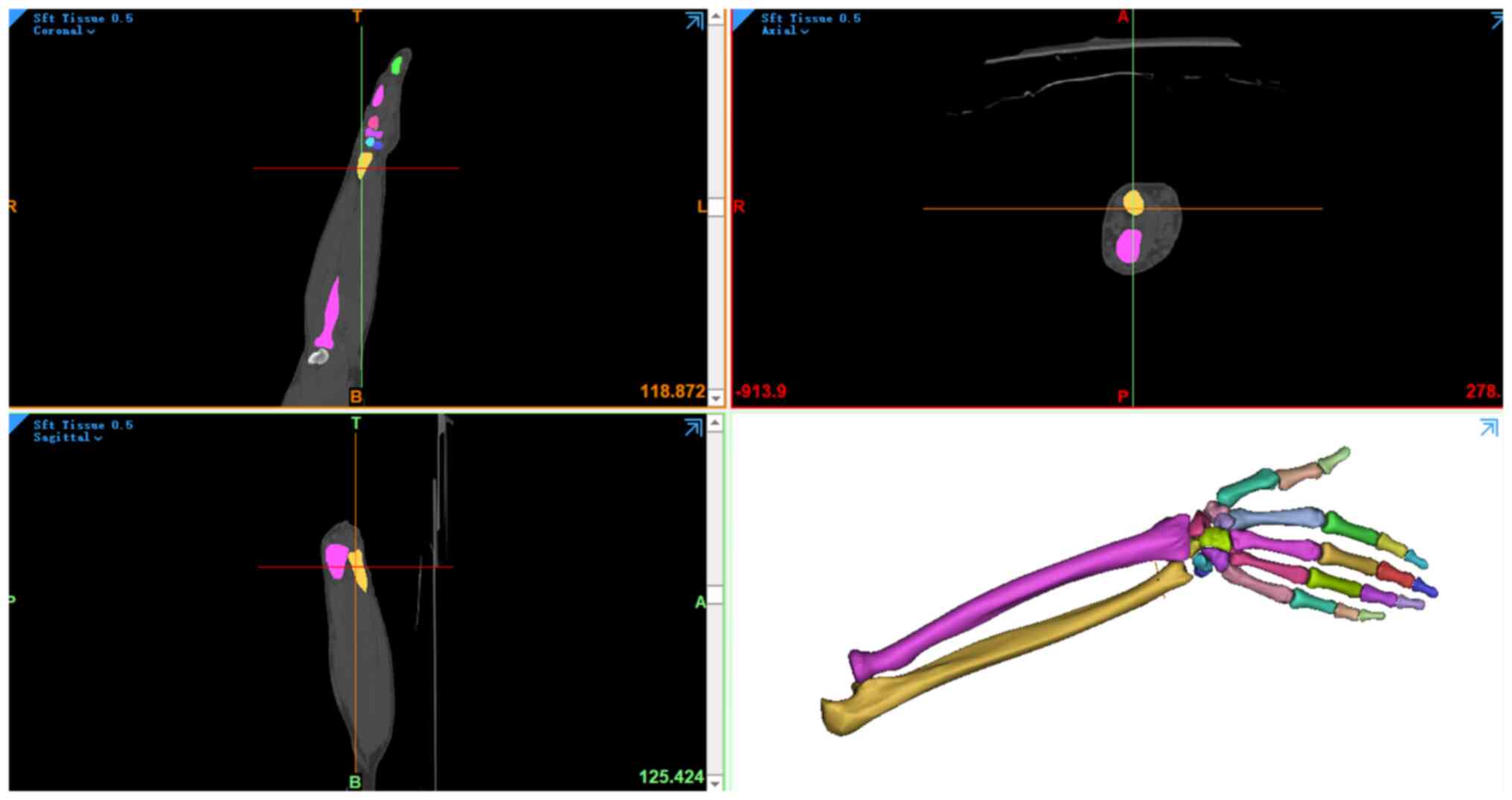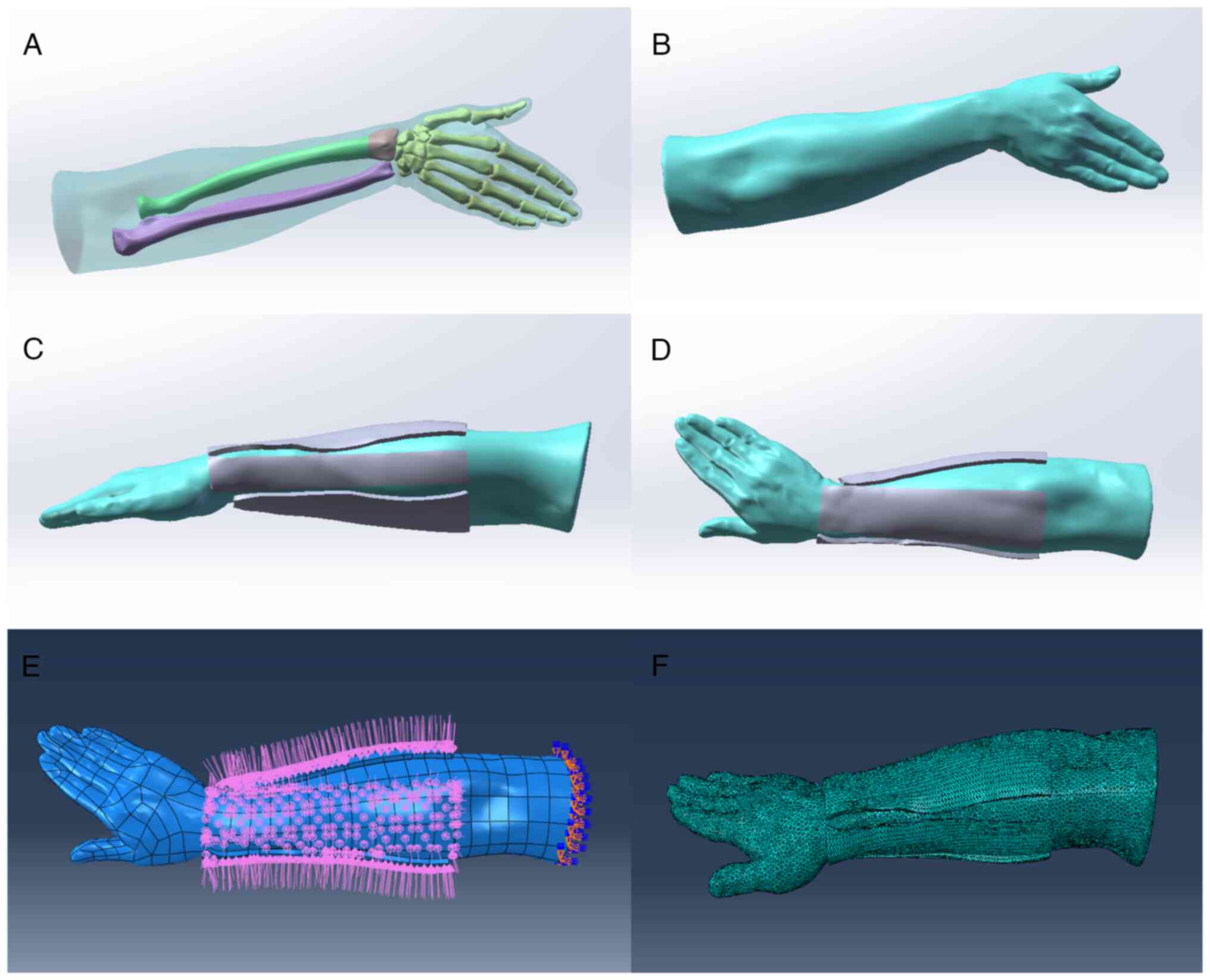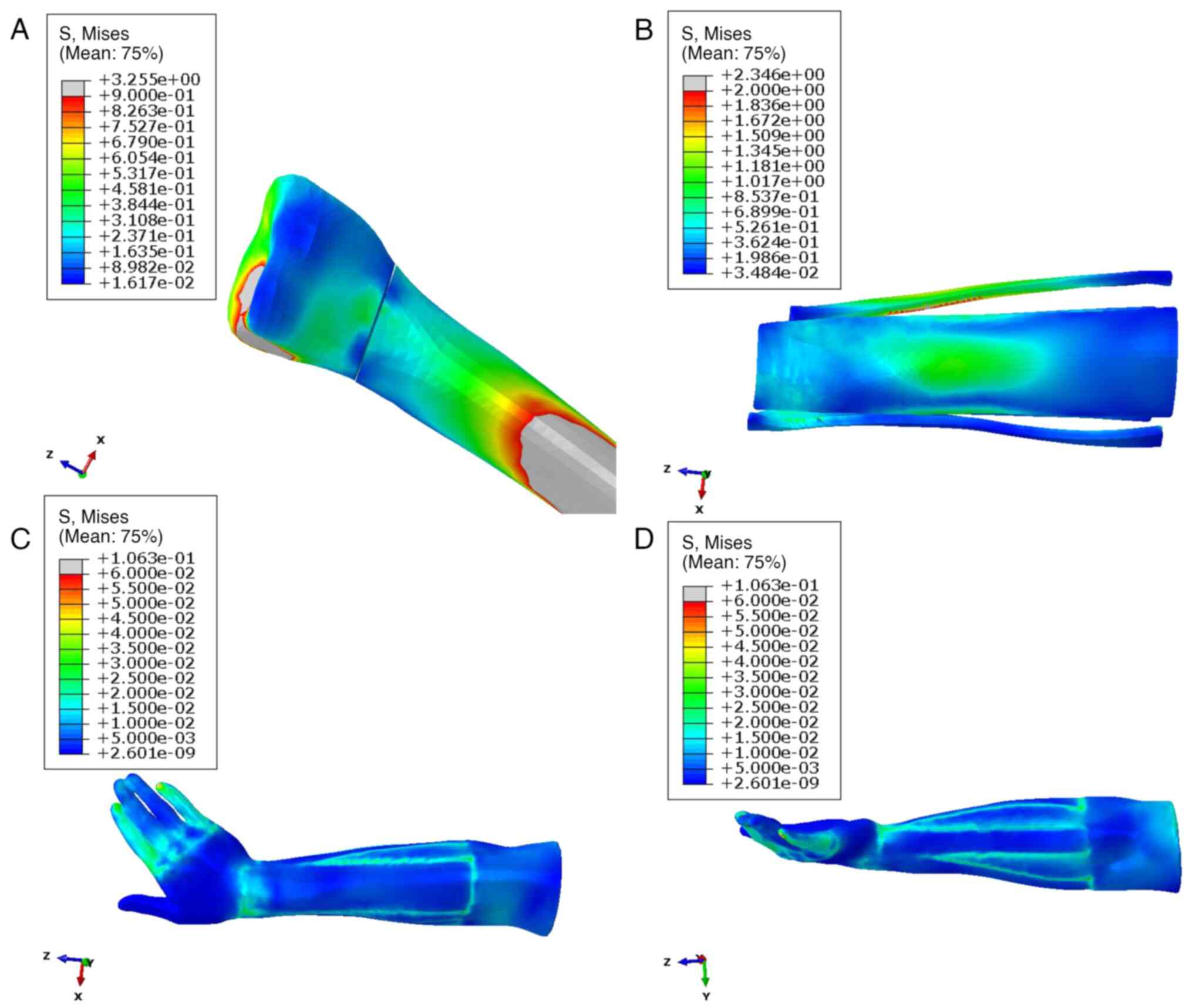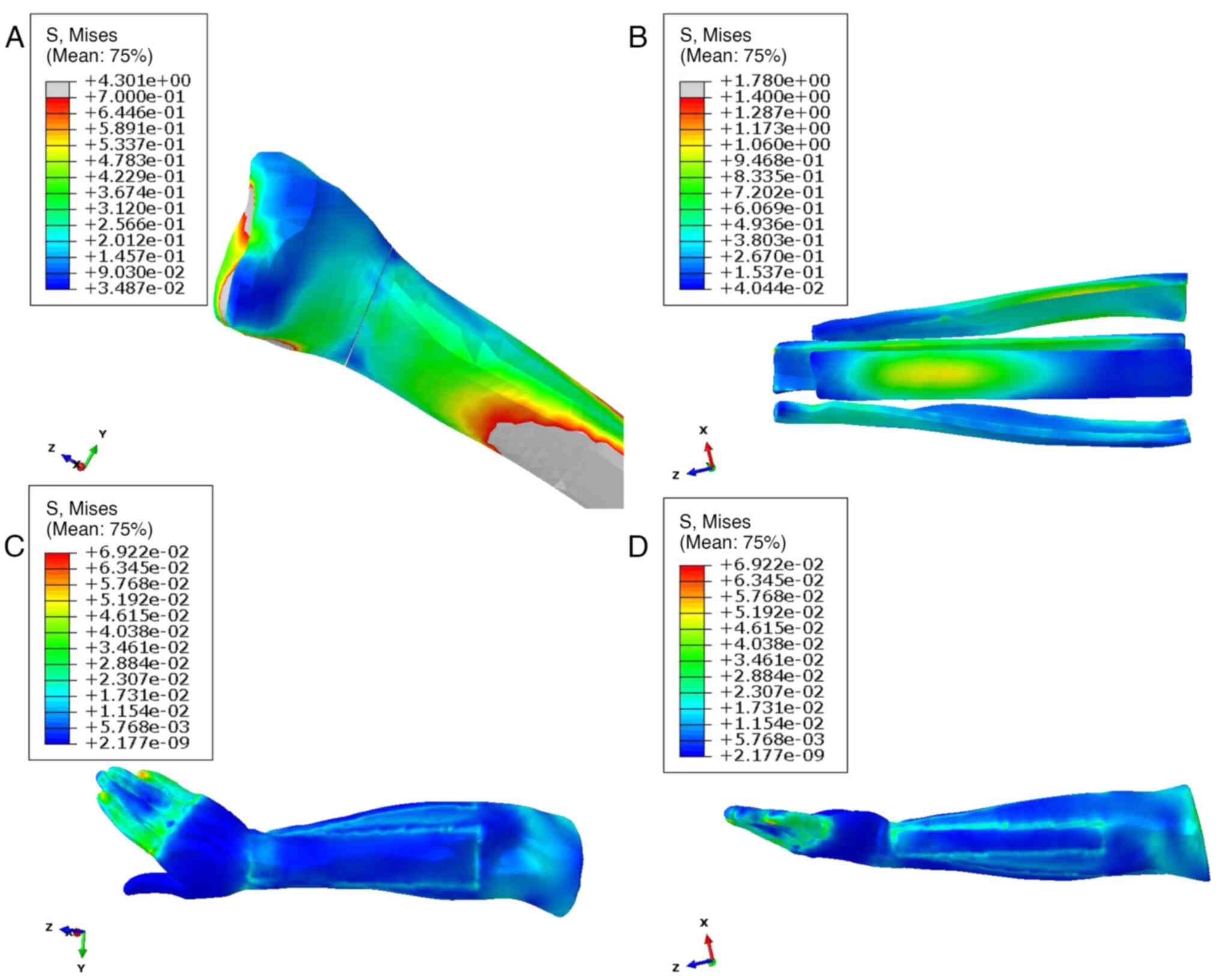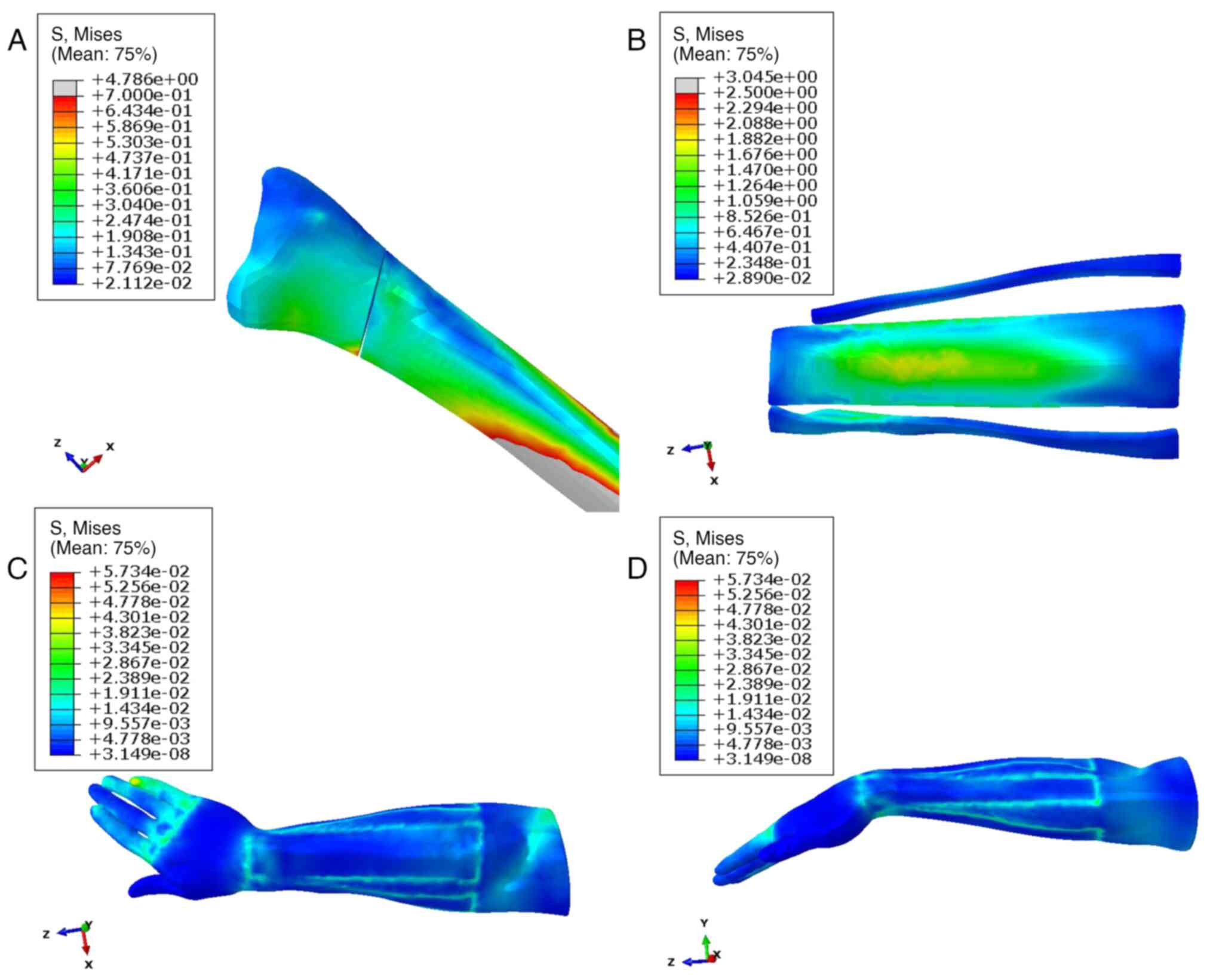|
1
|
Blakeney WG: Stabilization and treatment
of Colles' fractures in elderly patients. Clin Interv Aging.
5:337–344. 2010.PubMed/NCBI View Article : Google Scholar
|
|
2
|
Uppal G, Thakur A, Chauhan A and Bala S:
Magnesium based implants for functional bone tissue regeneration-A
review. J Magn Alloys. 10:356–386. 2022.
|
|
3
|
Mellstrand-Navarro C, Pettersson HJ,
Tornqvist H, Tornqvist H and Ponzer S: The operative treatment of
fractures of the distal radius is increasing: Results from a
nationwide Swedish study. Bone Joint J. 96-B:963–969.
2014.PubMed/NCBI View Article : Google Scholar
|
|
4
|
Hua Z, Wang JW, Lu ZF, Ma JW and Yin H:
The biomechanical analysis of three-dimensional distal radius
fracture model with different fixed splints. Technol Health Care.
26:329–341. 2018.PubMed/NCBI View Article : Google Scholar
|
|
5
|
Taylor M and Prendergast PJ: Four decades
of finite element analysis of orthopaedic devices: Where are we now
and what are the opportunities? J Biomech. 48:767–778.
2015.PubMed/NCBI View Article : Google Scholar
|
|
6
|
Yu XF: The Analysis of the curative effect
of different surgical methods on distal radius fracture and
biomechanical analysis of associated three-dimensional finite
element analysis model. Shijiazhuang: Hebei Medical University,
2021. Available from: https://d.wanfangdata.com.cn/thesis/D02511085.
|
|
7
|
Clough RW: The Finite Element Method in
Plane Stress Analysis. 1960. Available from: https://www.mendeley.com/catalogue/3dce7055-cde9-3d07-b2a8-712b203dd6a2/.
|
|
8
|
Rybicki EF, Simonen FA and Weis EB Jr: On
the mathematical analysis of stress in the human femur. J Biomech.
5:203–215. 1972.PubMed/NCBI View Article : Google Scholar
|
|
9
|
Brekelmans WA, Poort HW and Slooff TJ: A
new method to analyse the mechanical behaviour of skeletal parts.
Acta Orthop Scand. 43:301–317. 1972.PubMed/NCBI View Article : Google Scholar
|
|
10
|
Xiong H and Nie W: Accurate simulation of
stress state in bone joint and related soft tissue injury by
three-dimensional finite element analysis. Chi J Tissue Eng Res.
26:5875–5880. 2022.
|
|
11
|
Yang X, Li Y L and Liu DJ: Progress in the
application of three-dimensional finite element analysis in
anterior cruciate ligament reconstruction. Chi J Sports Med.
39:742–745. 2020.
|
|
12
|
Marongiu G, Leinardi L, Congia S, Frigau
L, Mola F and Capone A: Reliability and reproducibility of the new
AO/OTA 2018 classification system for proximal humeral fractures: A
comparison of three different classification systems. J Orthop
Traumatol. 21(4)2020.PubMed/NCBI View Article : Google Scholar
|
|
13
|
Fishman EK: CT scanning and data
post-processing with 3D and 4D reconstruction: Are we there yet?
Diagn Interv Imaging. 101:691–692. 2020.PubMed/NCBI View Article : Google Scholar
|
|
14
|
White NJ and Rollick NC: Injuries of the
scapholunate interosseous ligament: An update. J Am Acad Orthop
Surg. 23:691–703. 2015.PubMed/NCBI View Article : Google Scholar
|
|
15
|
Wang HJ: Atlas of Human Anatomy. Beijing:
People's Medical Publishing House Co., Ltd., 2005:411. Available
from: https://book.douban.com/subject/1448343/.
|
|
16
|
Xie RG, Tang JB and Tang TS: Morphological
and arthroscopical observation of the triangular fibrocartilage
complex of wrist. Chi J Joint Surg (Electronic Edition). 1:41–45.
2011.
|
|
17
|
Çelik A, Kovacı H, Saka G and Kaymaz İ:
Numerical investigation of mechanical effects caused by various
fixation positions on a new radius intramedullary nail. Comput
Methods Biomech Biomed Engin. 18:316–324. 2015.PubMed/NCBI View Article : Google Scholar
|
|
18
|
Mouzakis DE, Rachiotis G, Zaoutsos S,
Eleftheriou A and Malizos KN: Finite element simulation of the
mechanical impact of computer work on the carpal tunnel syndrome. J
Biomech. 47:2989–2994. 2014.PubMed/NCBI View Article : Google Scholar
|
|
19
|
Wei B, Xu ZC and Chang S: Biomechanical
properties of the lumbar pedicle screws by finite element analysis.
Chin J Tissue Eng Res. 22:3091–3096. 2018.
|
|
20
|
Xia CJ, Yuan ZF and Fang N: Biomechanical
characteristics of the distal radius fracture based on
three-dimensional finite element model of ulna and radius. Chi J
Tissue Eng Res. 24:893–897. 2020.
|
|
21
|
Matsuura Y, Kuniyoshi K, Suzuki T, Ogawa
Y, Sukegawa K, Rokkaku T and Takahashi K: Accuracy of
specimen-specific nonlinear finite element analysis for evaluation
of distal radius strength in cadaver material. J Orthop Sci.
19:1012–1018. 2014.PubMed/NCBI View Article : Google Scholar
|
|
22
|
Qin B, Huang YH and Ouyang Y: Finite
element analysis in scaphoid bone under action of axial stress. J
Army Med University. 32:1213–1315. 2010.
|
|
23
|
Li X: Splint binding force of small splint
for distal radius fracture on the elders: A clinical and
experimental quantitative research. Guangzhou: Guangzhou University
of Chinese Medicine, 2011. Available from: https://cdmd.cnki.com.cn/Article/CDMD-10572-1011132640.htm.
|
|
24
|
Wu ZP, Gao WY and Wu LJ: Progress of
finite element analysis on biomechanics of the wrist joint. Int J
Orthop. 29:307–309. 2008.
|
|
25
|
Zhou XN: Establishment of
three-dimensional finite element model of wrist joint and
biomechanical analysis of distal radius fracture. Beijing: Beijing
University of Chinese Medicine, 2014. Available from: https://cdmd.cnki.com.cn/Article/CDMD-10026-1014242530.htm.
|
|
26
|
Shapiro JA, Feinstein SD, Jewell E, Taylor
RR, Weinhold P and Draeger RW: A biomechanical comparison of
modified radioscapholunate fusion constructs for radiocarpal
arthritis. J Hand Surg Am. 45:983.e1–e7. 2020.PubMed/NCBI View Article : Google Scholar
|
|
27
|
Wang D, Li Y, Yin H, Li J, Qu J, Jiang M
and Tian J: Three-dimensional finite element analysis of optimal
distribution model of vertebroplasty. Ann Palliat Med. 9:1062–1072.
2020.PubMed/NCBI View Article : Google Scholar
|
|
28
|
Grafstein E, Stenstrom R, Christenson J,
Innes G, MacCormack R, Jackson C, Stothers K and Goetz T: A
prospective randomized controlled trial comparing circumferential
casting and splinting in displaced Colles fractures. CJEM.
12:192–200. 2010.PubMed/NCBI View Article : Google Scholar
|
|
29
|
Li DL and Shi JM: Efficacy analysis of
different treatment on distal radius comminuted fracture in elderly
patients. Chi J Trad Med Traumatol Orthop. 41–43. 2012.
|
|
30
|
Huang AY, Li GQ and Cao LB: Treatment of
270 cases of colles fracture with Li's Manual reduction and willow
splint fixation. J Ext Ther Trad Chi Med. 64–66. 2022.
|
|
31
|
Salmon P: Loss of chaotic trabecular
structure in OPG-deficient juvenile Paget's disease patients
indicates a chaogenic role for OPG in nonlinear pattern formation
of trabecular bone. J Bone Miner Res. 19:695–702. 2004.PubMed/NCBI View Article : Google Scholar
|
|
32
|
Wear KA: Mechanisms of interaction of
ultrasound with cancellous bone: A review. IEEE Trans Ultrason
Ferroelectr Freq Control. 67:454–482. 2020.PubMed/NCBI View Article : Google Scholar
|
|
33
|
Steiner JA, Ferguson SJ and van Lenthe GH:
Computational analysis of primary implant stability in trabecular
bone. J Biomech. 48:807–815. 2015.PubMed/NCBI View Article : Google Scholar
|
|
34
|
Knothe Tate ML, Tami AE, Netrebko P, Milz
S and Docheva D: Multiscale computational and experimental
approaches to elucidate bone and ligament mechanobiology using the
ulna-radius-interosseous membrane construct as a model system.
Technol Health Care. 20:363–378. 2012.PubMed/NCBI View Article : Google Scholar
|
|
35
|
Oliva F, Buharaja R, Iundusi R and
Tarantino U: Leg fracture associated with synostosis of
interosseous membrane during running in a soccer player. Transl Med
UniSa. 17:1–5. 2018.PubMed/NCBI
|
|
36
|
He J, Ma X, Hu Y, Wang S, Cao H, Li N,
Wang G, Guo L and Zhao B: Investigation of the characteristics and
mechanism of interosseous membrane injuries in typical maisonneuve
fracture. Orthop Surg. 15:777–784. 2023.PubMed/NCBI View
Article : Google Scholar
|
|
37
|
Adams JE, Culp RW and Osterman AL:
Interosseous membrane reconstruction for the Essex-Lopresti injury.
J Hand Surg Am. 35:129–136. 2010.PubMed/NCBI View Article : Google Scholar
|
|
38
|
Thangavel M and Elsen Selvam R: Review of
physical, mechanical, and biological characteristics of 3D-Printed
bioceramic scaffolds for bone tissue engineering applications. ACS
Biomater Sci Eng. 8:5060–5093. 2022.PubMed/NCBI View Article : Google Scholar
|















